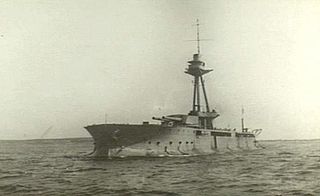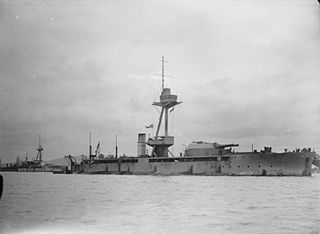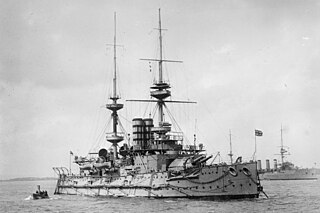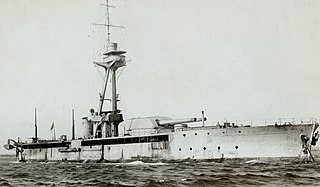
The M29 class comprised five monitors of the Royal Navy, all built and launched during 1915.

HMS Raglan was a First World War Royal Navy Abercrombie-class monitor, which was sunk during the Battle of Imbros in January 1918.

The Lord Clive-class monitor, sometimes referred to as the General Wolfe class, were ships designed for shore bombardment and were constructed for the Royal Navy during the First World War.

The Marshal Ney class was a class of monitor built for the Royal Navy during the First World War.

HMS Abercrombie was a First World War Royal Navy Abercrombie-class monitor.

HMS Crusader was a Tribal-class destroyer of the Royal Navy launched in 1909. During the First World War she served in the North Sea and the English Channel with the 6th Destroyer Flotilla. Following the War she was sold for scrap to Thos. W. Ward on 30 June 1920 for scrapping at Preston.

HMS Earl of Peterborough was a First World War Royal Navy Lord Clive-class monitor, named after Charles Mordaunt, 3rd Earl of Peterborough, a British general of the War of the Spanish Succession who fought in Spain. The ship's original 12-inch main battery was stripped from an obsolete Majestic-class battleship, HMS Mars.
HMS Prince Eugene was one of eight Lord Clive-class monitors built for the Royal Navy in 1915 to conduct shore bombardments during the First World War. The ship was assigned to the Dover Patrol for the duration of the war and provided cover for the Inshore Squadron during the First Ostend Raid. She was sold for scrap in 1921.

HMS Marshal Soult was a Royal Navy Marshal Ney-class monitor constructed in the opening years of the First World War. Laid down as M14, she was named after the French general of the Napoleonic Wars Marshal Nicolas Jean de Dieu Soult. She served in both World Wars and was decommissioned in 1946.

HMS Prince Rupert was a First World War Royal Navy Lord Clive-class monitor named after Prince Rupert of the Rhine, an important Royalist commander of the English Civil War and key figure in the Restoration navy. Although she is the only ship of the Royal Navy to have ever had this precise name, other ships have been named after Prince Rupert as HMS Rupert. Her 12" main battery was stripped from the obsolete Majestic-class battleships.

HMS General Wolfe, also known as Wolfe, was a Lord Clive-class monitor which was built in 1915 for shore-bombardment duties in the First World War. Her class of eight ships was armed by four obsolete Majestic-class pre-dreadnoughts which had their 12-inch guns and mounts removed, modified and installed in the newly built monitors. Wolfe spent her entire war service with the Dover Patrol, bombarding the German-occupied Belgian coastline, which had been heavily fortified. In the spring of 1918 she was fitted with an 18-inch (457 mm) gun, with which she made the longest-range firing in the history of the Royal Navy - 36,000-yard (20 mi) - on a target at Snaeskerke, Belgium. After the war, she was laid up before being stripped and put up for sale in 1920. She was finally scrapped in 1923.
HMS Sir John Moore was one of eight Lord Clive-class monitors built for the Royal Navy in 1915 to conduct shore bombardments during the First World War. The ship was assigned to the Dover Patrol for the duration of the war and was sold for scrap in 1921.

HMS Mars was a Royal Navy pre-dreadnought battleship of the Majestic class, the seventh member of a class of nine ships. The ship was laid down in the Laird Brothers shipyard in June 1894, she was launched in March 1896, and she was commissioned into the fleet in June 1897. She was armed with a main battery of four 12-inch (305 mm) guns and a secondary battery of twelve 6-inch (152 mm) guns. The ship had a top speed of 16 knots.

HMS Havelock was an Abercrombie-class monitor of the Royal Navy that saw service in the First World War.

HMS Roberts was an Abercrombie-class monitor of the Royal Navy that served in the First World War.

HMS Abercrombie was a Royal Navy Roberts-class monitor of the Second World War. She was the second monitor to be named after General Sir Ralph Abercrombie.

HMS M31 was an M29-class monitor of the Royal Navy.
HMS M28 was a First World War Royal Navy M15-class monitor. She was sunk during the Battle of Imbros in 1918.
HMS M27 was a First World War Royal Navy M15-class monitor. She was also served in the British intervention in Russia in 1919, and was scuttled in the Dvina River on 16 September 1919.
HMS M25 was a First World War Royal Navy M15-class monitor. She was also served in the British intervention in Russia in 1919, and was scuttled in the Dvina River on 16 September 1919.















